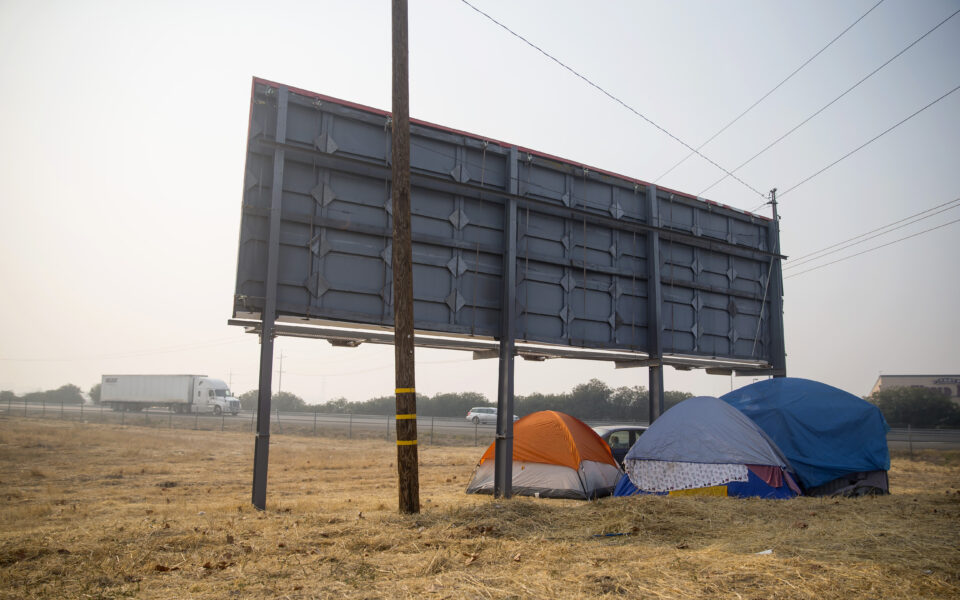The long emergency of homelessness

In October 2018, the city of Chico, California, bowed to a grim reality – too few shelter beds for too many people without places to sleep – and declared an emergency shelter crisis. The following month, the most destructive wildfire in California’s history ripped through the neighboring town of Paradise, destroying thousands of homes.
With local shelters already over-full, many evacuees joined the many others with nowhere to live, camping out in Chico’s fields and public spaces.
Trucks carrying goods arrived from around the country in the aftermath of the wildfire. Housed residents grieved alongside survivors of the blaze in Chico’s churches. World Central Kitchen staged Thanksgiving dinner in an auditorium for 15,000 people without tables of their own.
As the months passed, though, the sudden emergency of the wildfires began to blur into the long emergency of homelessness, which the fires had only amplified. Attitudes toward people living rough in the area – already curdling when the fires struck – hardened further. Some who were welcomed as survivors came to be scorned as “transients.” Residents voted in a slate of City Council members promising to crack down on encampments. One promised: “I will support ordinances that make it uncomfortable to live in our public spaces and prey on the generosity of our community.”
I write to you as the editor of the Headway team at The New York Times. We’re exploring the world’s challenges through the lens of progress. From the start, we knew we’d be wrestling with the growing global challenge of housing. All over the world, living situations are becoming more contingent. The reasons – climate change, unaffordable rents, war, missing or devastated infrastructure, rapid migration to cities – vary, but one consequence is clear: People are increasingly living and sleeping in unauthorized places. The suffering and conflict this creates can turn communities inward against themselves, pitting neighbor against neighbor in fights with brutal consequences.
Like any disaster, the loss of housing often strikes with little forewarning – sometimes gradually, and sometimes after months of threatening weather that suddenly loses all restraint. But Chico’s experience illustrates a dynamic that has bedeviled many cities’ responses to the housing crisis: Communities often come together after collective traumas. Homelessness drives us apart.
Over the past year, the Headway team has been reporting on communities all over the country reckoning with homelessness. We asked people to tell us about their own experiences, and in the scores of messages we received, two themes emerged: Homelessness, many stressed, is a systemic, collective challenge that needs a commensurate response; and we can only truly understand how its underlying systems work by following those who are reckoning with it themselves.
Houston has been held up across the country as the big city that has made the deepest and most persistent progress in shrinking the number of people classified as homeless. Michael Kimmelman, Headway’s editor at large and the Times’ chief architecture critic, and Lucy Tompkins, a reporter on the Headway team, spent time in Houston getting to know many of the people responsible for the city’s approach to homelessness, as well as those experiencing it. What they found is that Houston has been singularly focused on uniting behind a shared mission: getting its most vulnerable residents into homes.
Most big cities have a sprawling network of government agencies, private landlords, shelters, religious organizations and other groups that coordinate or provide various forms of housing and shelter. In many places, they all have wildly different, often competing incentives and ambitions, struggling over how to house people as rents and evictions soar and units grow scarcer. Houston has gone further than most major metropolitan areas to steer these stakeholders in a common direction. The number of people experiencing homelessness in Houston has fallen by 63% since 2011, at last count.
But peer behind the statistics to the stories buried within them, and challenging trade-offs present themselves, such as deciding who is most vulnerable. Houston does this with a customized version of the assessment used nationwide to prioritize placement for housing.
Wendy Marcum, one of the Houstonians whose stories we followed, sat down one day with a shelter worker who asked her a series of standardized questions: “Where did you sleep last night?” “Have you been homeless before?”
This was a high-stakes interview. The answers are a critical factor in determining how much housing assistance someone might receive. But in many contexts, such as applying for jobs or apartments, answering questions like these honestly can invite discrimination – or worse. The first time Marcum was scored, she didn’t mention her depression or medications. She was offered help with groceries, but not with housing. Months later, she got the chance to be rescored, and this time she was more forthcoming. She was offered a voucher to cover a year of rent, if she could find a landlord who would take it.
Marcum’s tale illuminates the winding turns people are taking in their journeys through the housing crisis. In each case, the city has managed to get them into apartments, but their arrangements are not permanent. Is this the best a big city can achieve against homelessness in the US? As the Headway team continues our pursuit of progress – what it is and how it can be made – we want to follow stories like these to understand how the system can be made better.
If we understood homelessness as a collective disaster, like a fire that is engulfing our communities, how would we want those communities to evolve? Whose examples would we want to follow? Whose mistakes would we want to avoid? What aspects of the system creating and responding to homelessness do we need to see most clearly?
In California, the crisis is at a different scale than it is in Houston. It will take years to build the amount of housing necessary to accommodate people who need it. In the interim, what can be done for communities with masses of people who have no place to live?
After Chico became more aggressive about enforcing its anti-camping ordinances, a group of the city’s unhoused residents sued and won an injunction against the city. Police were prohibited from clearing encampments until alternative sites for shelter were identified. In response, the city built 177 Pallet shelters; in April, the first inhabitants moved in. Their experience will number among hundreds of experiments in transitional housing around the country. Which have yielded the best results?
With federal funding for housing flatlining and few paths to federal legislation to help states and municipalities manage the crisis, places like Arizona and Philadelphia have turned to a perhaps-unlikely source: Medicaid. Their argument is that housing their most vulnerable residents saves the program money in expensive emergency room visits and other costs, with better health outcomes. Is this a path other communities should pursue?
These are some of the questions we are asking about our housing system. In the months to come, we’ll look at efforts to keep people rooted in communities as housing prices and property values soar. Given the combination of stagnating incomes and rising rents expelling people from homes, we’ll review results from waves of experiments around the country in providing guaranteed incomes. We’ll explore what else we can learn from communities rebuilding in the wake of disaster.
This article originally appeared in The New York Times.






